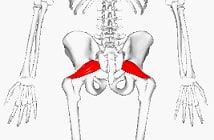The adjective piriformis describes what has a pear-like appearance. The term is usually used to refer to a muscle found in the gluteal area.
It comes from the union of two Latin elements: the noun “pirum”, which can be translated as “pear”, and the word “form”, which is synonymous with “image” or “figure”.
 The piriformis muscle is flattened and triangular in shape at its outer apex. It arises in the sacral bone , inserts into the greater trochanter and divides the greater sciatic foramen into two.
The piriformis muscle is flattened and triangular in shape at its outer apex. It arises in the sacral bone , inserts into the greater trochanter and divides the greater sciatic foramen into two.
The function of the piriformis muscle is abduction, external rotation and extension of the femur . These actions can be carried out if the pelvis is fixed.
A pathology characterized by numbness and pain in the back of the legs and buttocks is known as piriformis syndrome or piriformis muscle syndrome .
This syndrome, more common in women than in men although uncommon in general, occurs when the piriformis muscle generates pressure on the sciatic nerve . If the piriformis muscle is irritated or injured, spasms may occur, which, in turn, generate tension and inflammation; In this setting, the piriformis muscle presses on the sciatic nerve below it.
In the same way, we cannot ignore that other symptoms that may indicate that you suffer from the aforementioned piriformis syndrome are feeling pain when going up or down stairs, a reduced range of mobility in the hip joint and even having a Dull pain in the buttocks.
These symptoms are considered to worsen significantly when walking or running. On the contrary, they usually improve when the affected person lies on their back.
Spasms of the piriformis muscle can be caused by excessive physical activity, by lifting a very heavy item or by sitting for a long time, for example. Trauma can also cause this condition. With piriformis syndrome, the pain usually affects only one side of the lower body.
To diagnose the syndrome in question, the doctor will need to perform a physical examination of the patient in question and may even request different tests to rule out that he or she suffers from, for example, a lumbar disc herniation. Not to mention that, in addition, he will proceed to study the patient's clinical history.
When faced with piriformis muscle syndrome, a doctor must indicate the best treatment according to the individual case. Specialists generally prescribe painkillers , make postural recommendations and suggest rest until the discomfort disappears.
Likewise, the treatment may consist of injecting the patient with a local corticosteroid or an anesthetic or even cold therapies, through the application of ice packs, or heat, with pads that provide it.
In the same way, those who suffer from piriformis syndrome will be recommended to avoid activities that may cause pain, such as riding a bicycle; that you should do stretches as instructed by your doctor and that you must choose to adopt a correct posture in certain situations such as when sitting, for example.
